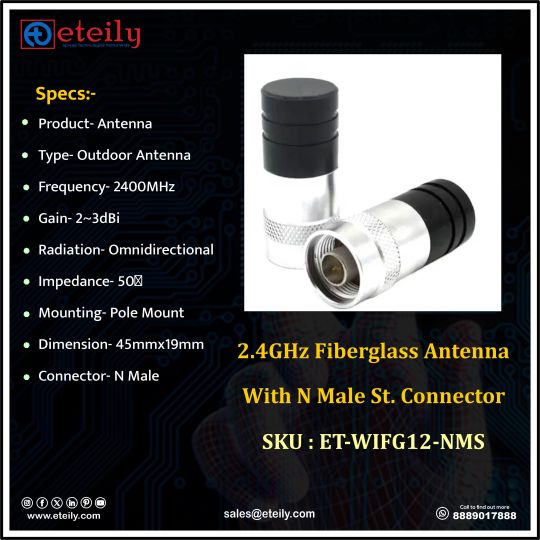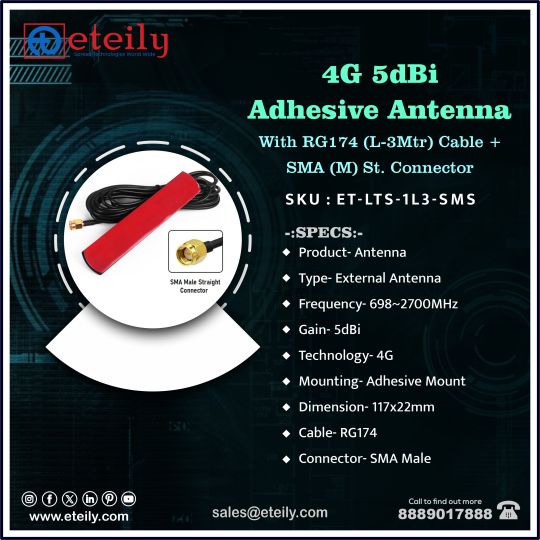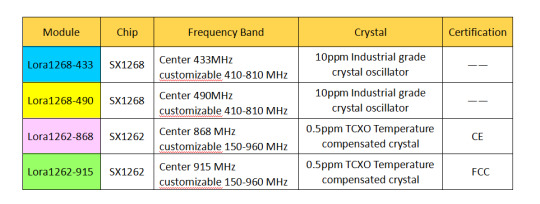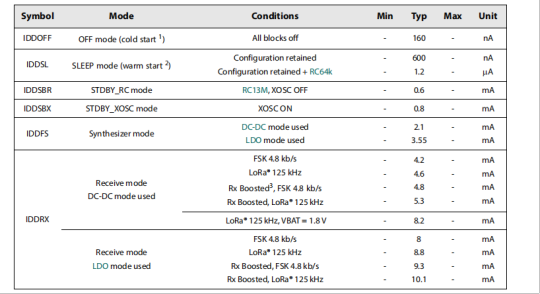#Lora Antenna 915mhz
Text
youtube
#915 MHz Antennas#Lora Antenna 915mhz#SMA Connector#915MHz LoRa Gateway Antenna#ISM chip antenna#Omni-Directional Antenna#High-Efficiency Antenna#fiberglass omnidirectional outdoor antenna#5 dBi Dipole Antenna#Ceramic Antenna#High gain antenna#UHF 915 MHz RFID ANTENNAS#Spring Antenna#RFantenna#EVcharger#iotloraantenna#Youtube
0 notes
Text

2G/3G/4G Combo Screw Mount Antenna with RG174 Cable (L-3MTR) + SMA (M) St. Connector
A 2G/3G/4G combo screw mount antenna is a type of antenna designed to support multiple generations of cellular technology, namely 2G (GSM), 3G (UMTS), and 4G (LTE). These antennas are typically used in applications where there's a need for reliable cellular communication across different generations of networks.
The "screw mount" aspect refers to how the antenna is installed; it typically involves screwing the antenna onto a suitable surface, such as the roof of a vehicle or a fixed structure. This type of mounting provides stability and durability, making it suitable for outdoor and rugged environments.
#rf antenna#RF Antenna#celluler antenna#5g antenna#5G Internal Antenna#5G External Antenna#5G Outdoor Antenna#4G LTE Antenna#4G Internal Antenna#4G External Antenna#4G Outdoor Antenna#3G Antenna#3G Internal Antenna#3G External Antenna#3G Outdoor Antenna#2G/GSM Antenna#2G Internal Antenna#2G External Antenna#2G Outdoor Antenna#IoT Lora LPWAN#868MHz Antenna#433MHz Antenna#915MHz Antenna#925MHz Antenna
0 notes
Text

2.4GHz Fiberglass Antenna With N Male St. Connector
A 2.4GHz #fiberglassantenna refers to an antenna designed to operate in the 2.4 gigahertz (GHz) frequency range. This frequency range is commonly used for various wireless communication applications, including Wi-Fi, Bluetooth, and some remote control systems.
Fiberglass antennas are popular for #outdoor applications due to their durability and resistance to weather conditions. The fiberglass material used in the antenna construction provides protection against environmental factors such as rain, sunlight, and wind.
Know More At -
Contact Us - 8889017888 📞
👉Website - https://eteily.com/3-rf-antenna
#telecom#rfantenna#rf#outdoor#antenna#frequency#eteily#connector#omnidirectional#manufacturers#telecomcompany#india#fiberglass
#fiberglass antenna#5.8dbi fiberglass antenna#8dbi fiberglass antenna#permanent fiberglass antenna mast#military surplus fiberglass antenna#lora fiberglass antenna#fiberglass vs aluminum antenna#fiberglass cb antenna#fiberglass antenna boat#fiberglass radio antenna boat#fiberglass marine band antenna#best fiberglass antenna#buy fiberglass antenna#fiberglass cb antenna spring#fiberglass dipole antennas#6 dbi fiberglass lora antenna#dual fiberglass cb antenna#915mhz 6 dbi fiberglass lora antenna#fiberglass pole for antenna
0 notes
Text
0 notes
Text
LoRa126X Series LoRa Modules: Designed Specifically for the Internet of Things
The LoRa1262 is a series of LoRa front-end modules developed by NiceRF Wireless for IoT applications, utilizing Semtech's SX1262 and SX1268 chips. This series features a compact size, low power consumption, and high sensitivity. It is produced and tested in strict compliance with lead-free processes, meeting RoHS and REACH environmental standards. Additionally, the LoRa1262 series has obtained international certifications, including CE and FCC.
LoRa126X Series Models
The LoRa126X series includes four products, covering operating frequencies of 433/490/868/915MHz. Among them, the LoRa1268 can be customized for frequencies ranging from 410-810MHz, and the LoRa1262 can be customized for frequencies ranging from 150-960MHz. Notably, the LoRa1262-868 is CE certified, and the LoRa1262-915 is FCC certified.


Uses LoRa spread spectrum chips
The LoRa126X modules use Semtech's SX1262 and SX1268 chips, which employ LoRa spread spectrum and frequency hopping modulation technology. Their communication range and reception sensitivity far exceed those of existing FSK and GFSK modulation technologies. Multiple transmission signals can share the same channel without interference, providing excellent anti-interference capabilities.
High performance in a compact size
The LoRa126X series module is a high-performance LoRa long-range transmission module featuring a compact size, ultra-low receiving current, and sleep current. It has a built-in 64KHz crystal oscillator that can wake up the microcontroller in low-power mode. The module's antenna switch can be controlled by the module's internal chip, saving external MCU resources. The LoRa126X module, with its compact size and 160mW output power, achieves a receiving sensitivity of -148dBm under LoRa modulation, providing a significant advantage for battery-powered applications.
Low Power Consumption Design
The LoRa126X has two power management modes for receiving current: LDO and DC-DC. In DC-DC mode, the minimum receiving current is 4.2mA for FSK modulation with 4.8 kb/s data transmission. For LoRa modulation with a 125 kHz signal bandwidth at 1.8V, the receiving current is 8.2mA. There are minor variations in the receiving current for both LoRa and FSK modulation under the Boosted setting.
Similarly, in LDO mode, the receiving current is minimized for FSK modulation. With Boosted improvements, the receiving current for LoRa modulation with a 125 kHz signal bandwidth is 10.1mA.

Can be used as a gateway node
The SX126X series modules can serve as LoRaWAN gateway nodes, capable of building LoRaWAN systems with NiceRF's LoRaWAN1302 and LoRaWAN1303 gateway modules. LoRa gateways collect messages transmitted by LoRa nodes and forward these messages to LoRaWAN servers, enabling communication from devices to the cloud.
Features:
Frequency Range:433/490/868/915 MHz (customizable150-960 MHz)
Sensitivity:-148dBm @Lora
Maximum output power:22 dBm(160mW)
Industrial grade high precision crystal oscillator
Lora,(G)FSK
256 bytes FiFo
Data transfer rate:
0.6-300 Kbps @FSK
0.018-62.5 Kbps @Lora
Application scenarios
This series of modules, with its low power consumption, combined with 100mW transmission power and compact size, is suitable for IoT applications such as remote meter reading, remote control, remote telemetry, and more
For details, please click:https://www.nicerf.com/products/
Or click:https://nicerf.en.alibaba.com/productlist.html?spm=a2700.shop_index.88.4.1fec2b006JKUsd
For consultation, please contact NiceRF (Email: [email protected]).
0 notes
Text
What is the difference between the LoRaWAN wireless module and LoRa gateway wireless transmission technology?
Many individuals find it challenging to differentiate between the LoRaWAN wireless module and LoRa gateway wireless transmission technology, as well as their applications within the realm of IoT.

LoRaWAN specifically pertains to the networking protocol found within the MAC (Media Access Control) layer. In contrast, LoRa serves as a protocol within the physical layer. Although current LoRaWAN networking implementations utilize LoRa as the physical layer, it's worth noting that the LoRaWAN protocol also allows for the use of GFSK (Gaussian Frequency-Shift Keying) as the physical layer in specific frequency bands. From a network layering perspective, LoRaWAN can adopt various physical layer protocols, just as LoRa can serve as the physical layer for other networking technologies.
LoRa, as a technology, falls under the category of LPWAN (Low-Power Wide-Area Network) communication technologies. It represents an ultra-long-distance wireless transmission method based on spread spectrum technology, pioneered and promoted by Semtech in the United States. This approach revolutionizes the previous trade-off between transmission distance and power consumption, offering users a straightforward system capable of achieving extended range, prolonged battery life, and increased capacity. Consequently, it expands the capabilities of sensor networks. Currently, LoRa predominantly operates within free frequency bands globally, including 433/868/915MHz, among others.
On the other hand, LoRaWAN wireless communication stands as an open standard defining the communication protocol for LPWAN technology based on LoRa chips. LoRaWAN defines the Media Access Control (MAC) layer at the data link level and is overseen by the LoRa Alliance. It's crucial to distinguish between LoRa and LoRaWAN because companies like Link Labs utilize a proprietary MAC layer in conjunction with LoRa chips to create more advanced hybrid designs, such as Link Labs' Symphony Link.
LoRaWAN typically employs a star or star-to-star topology, which is generally considered superior to mesh networks due to advantages such as conserving battery power and extending communication range. In a star topology, messages are relayed to a central server through gateways, and each end node can transmit data to multiple gateways. These gateways then forward the data to the web server, where tasks like redundancy detection, security checks, and message scheduling are executed.
In summary, LoRa encompasses solely the link layer protocol, making it suitable for point-to-point (P2P) communication between nodes. In contrast, LoRaWAN includes the network layer, allowing data to be sent to any base station connected to a cloud platform. By connecting the appropriate antenna to its socket, the LoRaWAN module can operate at different frequencies, offering versatility in its applications.
0 notes
Text
[Media] TTGO T-Beam ESP32 LoRa
TTGO T-Beam ESP32 LoRa
The TTGO T-Beam is a long-range wireless capable board supporting LoRa, built around a dual-core ESP32 chip with 4MB of SPI flash onboard, providing both Wi-Fi and Bluetooth LE.
The board's LoRa support comes in three different variants, operating at 433MHz, 868MHz, and 915MHz depending on region, with an included SMA antenna. Location tracking is provided by the onboard u-blox NEO-6M GPS module with ceramic antenna, and the board offers 26-pin headers with GPIO, ADC, VP/VN, DAC, touch, SPI, I2C, UART, 2דLoRa” pin, and power signals (5V/3.3V/GND).
The board can be programmed using the Arduino development environment, and example code shows you how to both send and receive data via LoRa. The board also includes a battery holder for a 18650 Li-Ion cell.
Repository:
https://github.com/Xinyuan-LilyGO/LilyGo-LoRa-Series
Buy online:
🛒 https://alii.pub/6mgzin
🛒 https://amzn.to/3Z2WUh4
#radio #lora #mesh #ESP32

0 notes
Text
0 notes
Photo

C&T RF Antennas Inc - SMA male swivel connector 915 Mhz Omni rubber duck antenna for ISM application
#C&T RF Antennas Inc#rf antenna#rf connector#rf cable#sma male connector#swivel sma male connector#915mhz#915mhz lora antenna#915#915mhz ISM antenna#omni antenna#custom antenna#smart home#omnidirectional antenna#omni wifi antenna#Lora band antenna#ISM antenna#lora application#ISM application#rubber ducky antenna#rubber duck antenna#indoor-outdoor antenna#external antenna
1 note
·
View note
Text
Top 10 Best hotspot antenna [2022]
Top 10 Best hotspot antenna [2022]
1. Signalplus Helium Bobcat HNT Hotspot Lora LoT Antenna 868/915mhz 10dbi 35.4inch+32.8ft SMA/RP-SMA Cable
Buy On Amazon
Shenzhen Qifan Communication Equipment Co., Ltd. was founded in 2009. We mainly focus on Antenna Researching ,Signal Electrical Production,Household Electric Appliances. We have awarded ISO9001 certification. What’s more, our products are earning positive reputation of market…

View On WordPress
0 notes
Text

#2G External Antenna#2G Outdoor Antenna#IoT Lora LPWAN#868MHz Antenna#433MHz Antenna#915MHz Antenna#925MHz Antenna#865MHz Antenna#GPS-GNSS ANTENNA#External GNSS GPS#Magnetic Antenna#Screw Mount Antenna#Adhesive Mount Antenna#GNSS GPS Marine Antenna#Internal GNSS GPS
0 notes
Text

4G 5dBi #AdhesiveAntenna With RG174 (L-3Mtr) Cable + SMA (M) St. Connector
SKU: ET-LTS-1L3-SMS
-SPECS:-
• Product Antenna
• Type-External Antenna
• Frequency-698~2700MHz
• Gain- SdBi
• Technology-4G
• Mounting Adhesive Mount
• Dimension-117x22mm
• Cable-RG174
• Connector- SMA Male
Know More At - https://eteily.com/3-rf-antenna


#eteily#technologies#eteilyindia#rfantenna#5g#4g#external#telecom#telecomunication#india
#5G Outdoor Antenna#4G LTE Antenna#4G Internal Antenna#4G External Antenna#4G Outdoor Antenna#3G Antenna#3G Internal Antenna#3G External Antenna#3G Outdoor Antenna#2G/GSM Antenna#2G Internal Antenna#2G External Antenna#2G Outdoor Antenna#IoT Lora LPWAN#868MHz Antenna#433MHz Antenna#915MHz Antenna#925MHz Antenna#865MHz Antenna#GPS-GNSS ANTENNA
0 notes
Text
LILYGO® TTGO T-Solar 433/868/915MHz Solar Power Development Board STM8L152 CPU SX1262 Lora With Antenna
LILYGO® TTGO T-Solar 433/868/915MHz Solar Power Development Board STM8L152 CPU SX1262 Lora With Antenna

lastest_volume
19
Just For Today
Click Here To Visit The Shop
N€W LILYGO® TTGO T-Solar 433/868/915MHz Solar Power Development Board STM8L152 CPU SX1262 Lora With Antenna
0 notes
Text
How much do you know about LoRa1262 and 1268? A detailed selection guide to help you learn more
LoRa1262 and LoRa1268 are ultra-low power wireless rf module designed with Semtech's SX1262 and SX1268X chips. They support both (G)FSK modulation and LoRa modulation. The LoRa modulation significantly extends communication range, making it suitable for various short-range IoT wireless communication applications. They feature small size, low power consumption, long transmission distance, and strong anti-interference capability.
Industrial crystals and supported frequency bands
SX1262 and SX1268 both utilize industrial-grade high-precision crystals. They can wake up the microcontroller on a timed basis while operating at low power. The module's antenna switch is internally integrated and controlled by the chip, saving external MCU resources. With compact size and 22dBm output power, they offer significant advantages in IoT and battery-powered applications.
SX1262 supports frequency bands in the range of 868MHz (customizable from 150MHz to 960MHz)
SX1268 supports frequency bands in the range of 433/490MHz (customizable from 410MHz to 810MHz)

According to the table above, it can be seen that LoRa1262 wireless rf module is equipped with a 0.5ppm TCXO temperature-compensated crystal oscillator, suitable for applications requiring extremely high accuracy, such as communication base stations and precision instruments. LoRa1262 has passed CE and FCC certifications for both the 868MHz and 915MHz frequency bands, meeting regulatory requirements for wireless devices in overseas markets.
SX1262 and SX1268 features
Small Size
The RF chip measures 4mm x 4mm, which is 45% smaller compared to the SX127x series ICs.
Low Receive Power Consumption
The RF receive power consumption is 4.8mA, which is more than halved compared to the SX127x series' 10mA receive current.
High Receiver Sensitivity
With a maximum sensitivity of -148dBm, it significantly enhances communication range.
High Data Rate
In LoRa mode, the maximum achievable data rate is 62.5kb/s with different spreading factors, and in GFSK mode, it supports up to 300kbps, programmable by the user. High Output Power: Capable of reaching a maximum output power of +22dBm, programmable by the user.
Selective Wake-up
Supports hardware address recognition, enabling selective wake-up functionality for the module.
Low Power Consumption
During sleep mode, the minimum power consumption is as low as 160nA.

The chart above shows the current consumption of LoRa1262/1268 modules, indicating two power management modes: LDO and DC-DC.
Under DC-DC mode, the minimum current consumption during FSK modulation with 4.8 kb/s data transmission is 4.2mA. For LoRa modulation with a 125kHz signal bandwidth and voltage of 1.8V, the receive current is 8.2mA. In Boosted mode, there is a slight variation in current for both LoRa and FSK modulation.
Similarly, under LDO mode, the minimum receive current is observed during FSK modulation, and under Boosted mode with LoRa modulation and 125kHz signal bandwidth, the receive current is 10.1mA.
It can be concluded that the key feature of LoRa1262 and LoRa1268 wireless rf module is low power consumption, with a minimum receive current of 4.2mA. They are suitable for low-power applications. Additionally, these modules can be equipped with industrial-grade temperature-compensated crystal oscillators, meeting the requirements of high-precision industrial applications.
We hope the above comparison analysis is helpful. For further information, please refer to the product specification sheet or contact us directly:
For details, please click:https://www.nicerf.com/products/
Or click:https://nicerf.en.alibaba.com/productlist.html...
For consultation, please contact NiceRF (Email: [email protected]).
0 notes
Text
LILYGO® TTGO ESP32 SX1276 LoRa V1.0 868 / 915MHz Bluetooth WI-FI Lora Internet Antenna Development Board
LILYGO® TTGO ESP32 SX1276 LoRa V1.0 868 / 915MHz Bluetooth WI-FI Lora Internet Antenna Development Board

LILYGO® TTGO ESP32 SX1276 LoRa V1.0 868 / 915MHz Bluetooth WI-FI Lora Internet Antenna Development Board
Price
3
Catch me HERE
0 notes